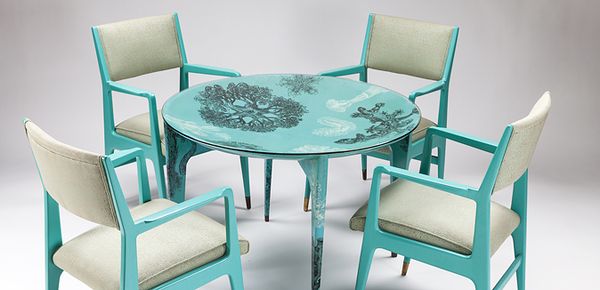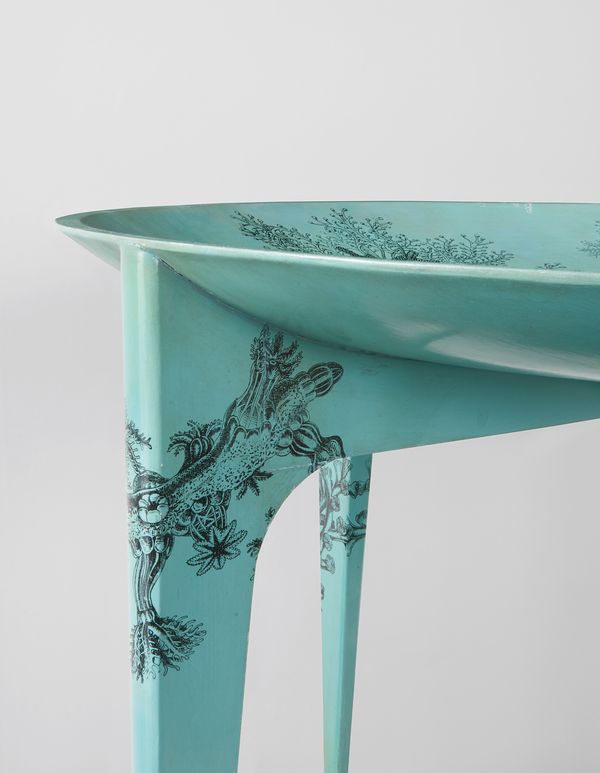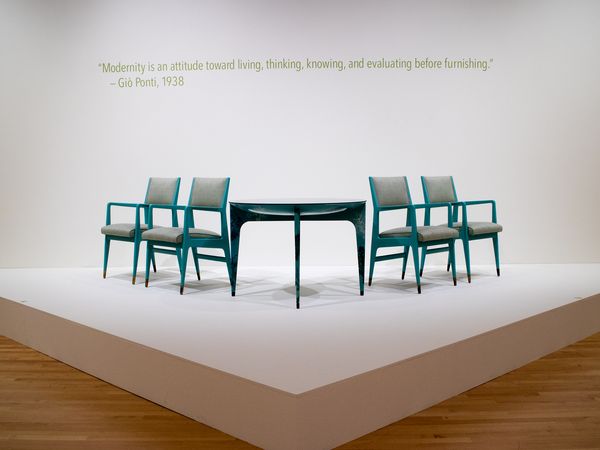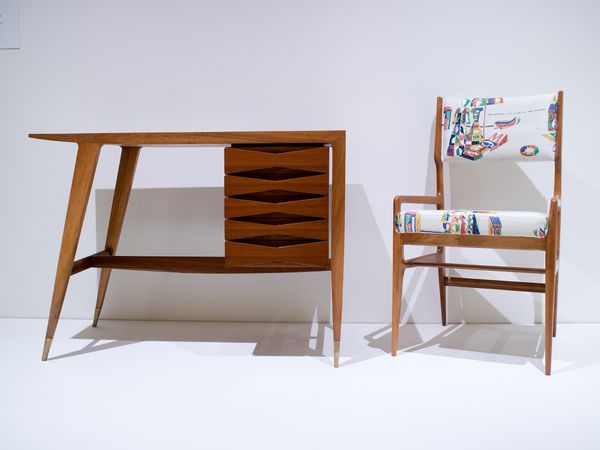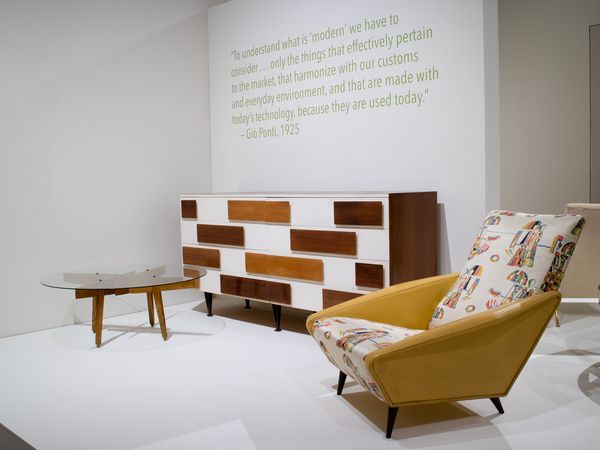Gio Ponti and Piero Fornasetti Madrepore Table, circa 1950 © Georgia Museum of Art
"Modern Living: Giò Ponti and the 20th-Century Aesthetics of Design" at the Georgia Museum of Art presents over 50 objects designed by Giò Ponti (1891-1979), the widely acknowledged father of modern Italian design whose prolific career spanned almost 60 years. The objects, which have been culled from American museums and private collections, celebrate the breadth and quality of Ponti's contributions to Italian design.
Phillips' Kimberly Sørensen spoke with the exhibition's curator, Perri Lee Roberts, Professor of Art History, University of Miami, to learn more about the genius behind Ponti's monumental contributions to Italian design and her curatorial approach.
Giò Ponti and Piero Fornasetti Rare Madrepore Table, circa 1950 from Phillips' Design sale in New York, June 2017. This piece sold for $125,000 at auction.
Kimberly Sørensen: Upon entering the exhibition, I was delighted to encounter the Madrepore dining table on loan from the Carnegie Museum of Art. We were honored to sell a nearly identical example in our June 2017 Design auction in New York. Why did you choose this particular object to open the exhibition?
Perri Lee Roberts: Historically, the Madrepore table is an important work in Ponti's career precisely because it is identical in terms of design, and similar in decoration, to the dining table which was displayed in "Italy at Work." The first major exhibition that introduced the American public to Italian craft and design, "Italy at Work" traveled to twelve museums across the United States from 1950 to 1953.
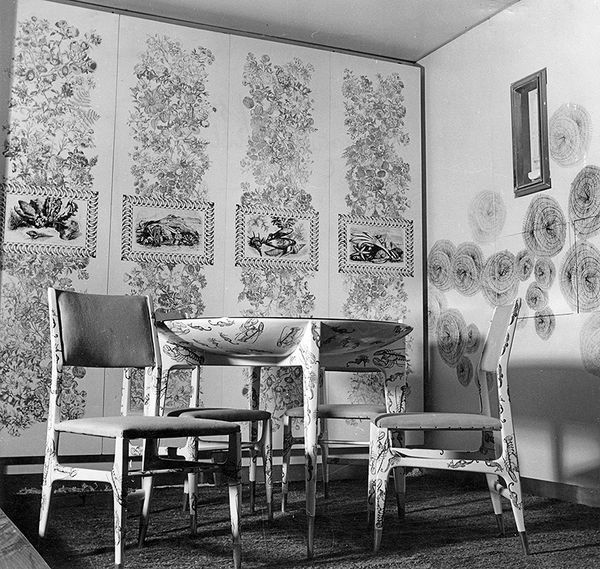
"Fish, Seahorses, and Crayfish" ("Pesci, cavallucci, marini e astici") installed in the exhibition "Italy at Work," Brooklyn Museum © Salvatore Licitra, Gio Ponti Archives
Furthermore, it is a wonderful example of the highly successful collaborative work of Ponti and Piero Fornasetti. Visitors will be attracted by the table's bright color and decorative designs. It draws people into the exhibition. The layout of the show was also dictated by the spatial requirements, specific loan stipulations (e.g., the piece had to be in the direct sightline of the guards or in a case, etc.) and aesthetic considerations.
KS: I can't think of any aspect of Italian design that Ponti left untouched, from furniture to textiles, glass, silver, enamels, ceramics and industrial products, such as the espresso machine he designed for Pavoni. Not to mention his contributions to design criticism through the publications Domus and Stile. How did you choose which objects to include from such a prolific artistic output?
PLR: My primary criteria was to secure the very best, authentic and characteristic examples of Ponti's work from the beginning of his career through the 1950s, balancing the selection of one-of-a-kind, commissioned works with those that were produced in greater number. I chose not to borrow any works by Ponti created after 1960 because I considered that his design style had fully evolved by that point.
Ponti did not believe that form follows function.
Installation views of "Modern Living: Giò Ponti and the 20th-Century Aesthetics of Design" © Georgia Museum of Art
KS: Speaking of design style, it seems to me that Ponti, with his use of decorative elements (such as Fornasetti's patterns) and historical motifs (i.e. his ceramics for Ginori), skirted more austere definitions of modernism held by many of his contemporaries who eschewed pattern and historical references. How would you summarize Ponti's design philosophy?
PLR: For Ponti and his contemporaries in Italy, classical art and architecture represented universally recognized and eternal ideals of visual beauty and harmony. These ideals were inextricably tied to the history and national patrimony of the Italian peninsula. Throughout his career he endlessly sought to create what he called the finite, "finished form...unchangeable, unrepeatable, unique and coherent." In marked distinction from his modernist colleagues working outside of Italy, Ponti did not believe that form follows function. Instead, he wrote, "Form is said to correspond to function. I am tempted to deny it and say that form is an ideal contribution, independent of functionality and originated from concepts of essentiality and truth, and that functionality, always implicit in everything, has nothing to do with the matter."
Many of Ponti's early commissions...came from wife [Giulia Vimercati]'s family in Milan.
KS: As a scholar of early Renaissance art, do you think you approached this project differently than a scholar of modern design or architecture might have?
PLR: I think I approached the project differently because I am an art historian as well as a scholar of Renaissance art. As an art historian, I looked at each of Ponti's pieces as individual works of art, which were often created for a specific patron and context. This was why I was particularly attracted to Ponti's one-of-a-kind, commissioned pieces. As a scholar of Renaissance and Italian art, I have a special appreciation for Ponti's life-long adherence to classical principles of design and beauty.
KS: What kind of relationship did Ponti have with his patrons? Was he willing to make accommodations and concessions based on his clients' wishes?
PLR: In 1921, Ponti married Giulia Vimercati, who hailed from one of Milan's most important families, which elevated his social status. Many of his early commissions and his job with Richard-Ginori came from his wife's family, relatives and friends. I believe Ponti had cordial relations with his clients, however his preference was to create every element of the architectural design, including all the interior furnishings.
Installation views of "Modern Living: Giò Ponti and the 20th-Century Aesthetics of Design" © Georgia Museum of Art
KS: What prompted the Georgia Museum of Art to host this exhibition? Did Ponti have a particular connection to the museum or to the University of Georgia?
PLR: The GMOA has a long history of hosting shows dedicated to Italian art and design. In 2014, for example, they hosted an exhibition of the work of Emilio Pucci in America, and have sponsored a number of shows of Italian Renaissance and Baroque art. The museum also recently added ceramics and silver by Ponti to their important collection of decorative arts. However, the primary reason was that the director of the museum, Dr. William Eiland, and I both have a special interest in his work and contributions to the history of modern design.
There is no question that Giò Ponti was a workaholic.
KS: Past retrospectives on Ponti have taken place in spaces devoted to twentieth-century design, such as the Triennale Design Museum, Milan ("Expressions of Giò Ponti," May 6-September 4, 2011) and the Design Museum, London ("Giò Ponti: A World', May 3-October 6, 2002). It's really interesting that "Modern Living" is on view in a much more diverse setting, in terms of collections, and that the GMOA is a university museum. Did this context inform your curatorial approach and do you think it will influence the way visitors experience the show?
PLR: As a university museum, the GMOA considers research an essential part of their mission, which they carry out through exhibitions, programming and scholarly publications. In the essay I wrote for the exhibition catalogue, "Modern Living: Giò Ponti and Twentieth Century Aesthetics of Design," I discuss the career and accomplishments of this highly accomplished architect, within the context of the evolution of European modern design and the development of Italian manufacturing.
Whereas the furniture and decorative objects on display are discussed chronologically in the catalogue, the works are arranged aesthetically within the exhibition galleries. For those visitors who are already familiar with Ponti's achievements, the endnotes to the essay provide references to additional literature about the architect and twentieth-century Italian design.
KS: One more question I have to ask: given his prolific output, I can only imagine that Ponti slept three hours a night and lived on espresso. Did you come across anything in your research about his work habits? How did he accomplish so much?
PLR: There is no question that Giò Ponti was a workaholic, surviving on only five hours of sleep a night. He was a very early riser and often worked at his studio into the evening; even after he arrived home for the night, he occupied himself making drawings and writing letters.
"Modern Living: Giò Ponti and the 20th-Century Aesthetics of Design" is on view at the Georgia Museum of Art through 17 September 2017.
